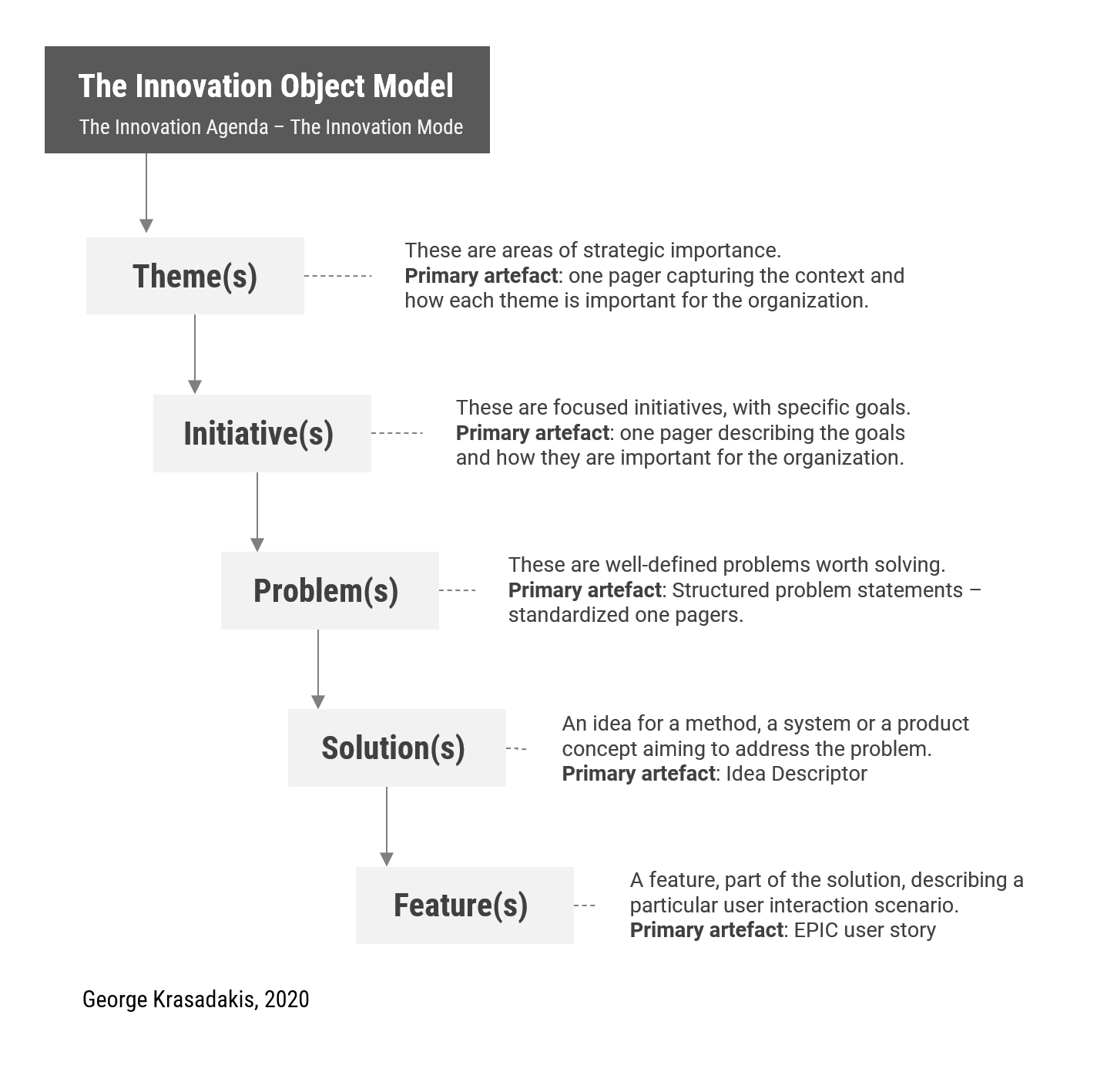Streamlining Ideation - the Idea Model
When ideating at scale, ideas need to come in a consistent form. This article presents the ‘idea model’ along with various examples of real ideas — explaining how to write effective executive summaries for your product or business concepts.
The problem with ideas in an innovation context is that they usually come in a wide range of formats and varying levels of detail and sophistication: Sometimes an idea is ‘expressed’ on a sticky note and put on the wall for ‘evaluation’. Often, ideas are documented and presented through lengthy and difficult-to-consume decks, that usually receive limited attention and engagement. Ideators need a standard, compact way of articulating ideas quickly while innovation leaders need a stream of consistent, standardized ideas, expressed in a comparable way. And this is exactly what the Idea Model is bringing in the innovation process — described in the following.
→ Check also: Building an MVP: How to define the first instance of your product A simple, powerful model for capturing ideas
Similar to the way user stories describe a feature of a product or a user need, the Universal Idea Model can capture any idea as a concrete, ‘executive summary’ statement. An idea can be named using a simple pattern like A/An <OBJECT> that <DOES SOMETHING> while the summary can be constructed as a short paragraph, using a simple format:
An <OBJECT> for <A CLASS OF USERS> that <DOES SOMETHING> in order to <ACHIEVE A GOAL>. Users benefit by <GETTING VALUE BACK> when <IN A SPECIFIC SITUATION>.
The six elements used in the above articulation are explained in the following:
The
<OBJECT>in the above structure is the shape that the idea could take if implemented — the envisioned form factor e.g. an app for smart devicesThe
<CLASS OF USERS>is a named group of users that are expected to get the most value from this idea, e.g. consumersThe
<DOES SOMETHING>element captures the operation or the function that the<OBJECT>performs, e.g. provides real-time price insights and product informationThe
<ACHIEVE A GOAL>element summarizes what the idea is trying to achieve through the<DOES SOMETHING>— the core function, e.g. to inform the consumer about a special, in-budget, nearby offer.The
<GETTING SOMETHING BACK>element summarizes the type of value the users are getting from the idea — how it generates value to the users, e.g. to inform the consumer about relevant product opportunities within their budget.The
<IN A SPECIFIC SITUATION>element summarizes the environment in which the users benefit from the idea, e.g. by discovering in-budget offers for products they need while in a physical store.
The next section presents real product ideas captured in my personal backlog using the Universal Idea Model.
Check also: our unique Innovation Toolkit - a collection of seven innovation templates that empower teams to frame problems, shape ideas, run hackathons, and more.
Example #1 - Finding the right participants for a business meeting
This is an idea about a system able to identify and recommend relevant and/or valuable participants for a business meeting (or project, or other business activity or collaborative engagement). One way to describe this idea is through a lengthy, unstructured, detailed description — starting with the problem, then describing the concept, and finally explaining the value. This might read like the following:
Business meetings are expensive to organize and run. In many cases, they are noisy with no actionable output — due to the non-optimal synthesis of the list of participants: People that should be present are not invited; for some of the participants the reason for being invited may not be clear. In many cases, there are too many people in the room making the actual discussion and collaboration inefficient and less actionable.
In such scenarios, when a user is setting up a business meeting or a session, an ‘intelligent’ system may capture and ‘understand’ the context of the meeting using NLP and then query the active directory of the organization along with a skills database and a shared calendar to find the most relevant and available people in the context of the particular meeting.
In one example, these candidate participants may be recommended based on a candidate score calculated for each candidate participant — based upon a variety of factors, including (1) the particular candidate participant’s relevance to the meeting topic, (2) the extent to which the particular candidate participant has positively contributed to previous meetings, and/or (3) whether the candidate participant has attended meetings that are particularly relevant to the topic.
Recommending meeting participants in this manner can reduce the potential for inviting low-value participants to meetings, as well as identifying and recommending potentially valuable meeting participants who would not otherwise attend.
While the above 231-word long paragraph provides a good description of the problem, the solution, and the benefit, it is too long (for an ideator to type, and for a stakeholder to engage with and quickly get the … idea). Especially if ideation is happening at scale, e.g. having a steady flow of ideas in an innovation context, this free-form idea description proves to be ineffective.
Moreover, the above description tends to be technical, e.g. it is talking about NLP, scores, factors, active directories, etc. — this makes it less inclusive as non-technical users might find it more difficult to follow. Using the Universal Idea Model, the ideator abstracts the concept, avoids the technicalities and unnecessary —when at an early stage — details, saves time, and gains clarity on the idea itself by summarizing it in the following way:
An AI-powered service FOR business users THAT is able to capture the context of a meeting and recommend the most suitable participants IN ORDER TO organize a better meeting with the right people in the room. USERS BENEFIT by instantly finding the right experts and decision-makers to invite WHEN they are setting up a business event.
The idea could be titled simply as ‘A digital assistant THAT recommends the most relevant participants for a business meeting.’
Example #2 - Tackling the problem of Fake News and misinformation
This idea is about a solution to the social media Fake News problem. One way to describe the solution would be through an article or a document like this one: Misinformation Online: A Universal Solution
However, the above-referenced article is an 8-minute read (1745-word long essay). When innovating, there must be a better way to summarize a newly-conceived idea — as the master entry- and then attach additional documents, descriptions, designs, and other artifacts — if and when they become available. Using the UMI (Universal Model for Ideas), the executive summary of this idea could be written as:
A decentralized system FOR online users, THAT systematically samples and processes cohorts of News and social posts IN ORDER TO identify ‘Fake News’ or misleading information and score content, social media and content distributors in terms of reliability - while notifying online users for their unconscious contribution via sharing fake content. USERS BENEFIT by realizing both their exposure and their unintentional contribution to the problem of Fake News WHEN they use social media to discover, consume, and share content.
The idea could be titled ‘A blockchain-powered content center THAT can retroactively score content and distributors based on their trustworthiness.‘
Example #3 — An Augmented Reality in-shop consumer advisor
In this example, the idea is about a smart, in-store shopping advisor for consumers — able to synthesize ‘smart’, personalized offers and deals to each consumer — by leveraging all the knowledge available to the consumer (history, preferences, lifetime value, etc.), the product catalog and the consumer base overall. Through a connected device, the system is able to identify the customer entering a physical store, and instantly compute a set of special deals and pricing elasticity — all computed according to the ‘value’, the profile, and the specifics of the customer. As the customer navigates the store, he/she browses physical products through the mobile device (or special, connected glasses) and experiences personalized deals — dynamic pricing and intelligent loyalty offers appearing as metadata, on the screen. On approval by the user — via a tap on the smartphone screen — the app notifies the loyalty system of the retailer, the order is placed and the user just confirms and pays — physically in the store or online with an extra step. All served as an instant, interactive, personalized AR experience — no cards, no coupons, no loyalty memberships. A seamless experience for both the customer and the retailer.
Using the Universal Model for Ideas, this rather complicated idea could be summarized as:
An Augmented Reality app FOR consumers THAT synthesizes product and pricing information as an augmented reality experience IN ORDER TO offer personalized offers to the consumer - in the form of special prices, loyalty schemes, or discounts. CONSUMERS BENEFIT by discovering better offers, in a personalized manner WHEN they are exploring products in a physical retail store. RETAILERS BENEFIT by optimizing their loyalty schemes and enabling a seamless, personalized in-store experience WHEN they are trying to drive sales through physical stores.
Note that in this example, there are two statements regarding the benefit for the user — one for the consumers and one for the Retailers. The idea could be titled ‘An Augmented Experience THAT allows retailers to offer personalized offers to their customers in physical stores.‘
Example #4 — A situation-aware ‘Do Not Disturb’ app for smartphones and wearables
This example is about summarizing an idea about an ‘intelligent’ Do Not Disturb mode for smart devices, that is triggered by certain attributes of the current social arrangement. This can be described as in this article or using the following compact form based on the UMI - Universal Model for Ideas:
An O/S-level software component FOR smartphone users THAT is able to identify certain social occasions as ‘noise sensitive’ IN ORDER TO minimize the disturbance from mobile ringtones and app notifications. USERS BENEFIT from a generalized socially responsible use of smartphones WHEN in a place or occasion that requires focus or quietness.
A title for the idea would be: ‘A smart DnD assistant THAT understands the special character of the occasion and recommends or sets a certain 'notification mode'
→ Check also: our unique Innovation Toolkit - a collection of seven innovation templates that empower teams to frame problems, shape ideas, run hackathons, and more.
The Universal Ideas Model can be used as a simple form or verbally, in workshops and brainstorming sessions. Ideally, it should evolve as a part of a shared innovation language — allowing teams across the organization to exchange ideas in a compact, solid format.
A centralized database of ideas captured using this model can make the discovery and utilization of ideas, easier and most efficient. Most importantly, it can increase the chances of discovering great, high-potential ideas and innovation opportunities.
Ideas can be seen as part of the overall ‘innovation Object model’ - mapped at the solutions and ideas level.
Check our Innovation Toolkit - a collection of seven innovation templates that empower teams to frame problems, shape ideas, run hackathons and more.
Also promoted through www.productschool.com communities.





Digital Transformation – What is it all about? Erik Schumb, founder & CXO, Agile Sprints and one of the '60 Leaders on Innovation' shares his insights.